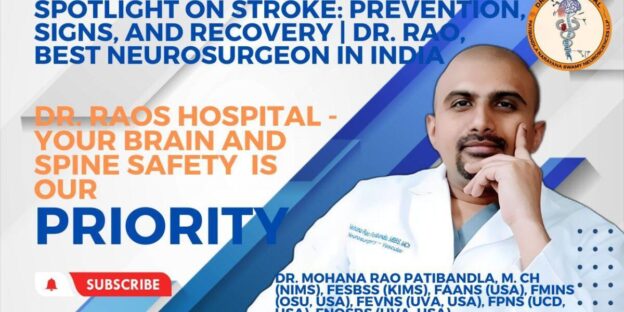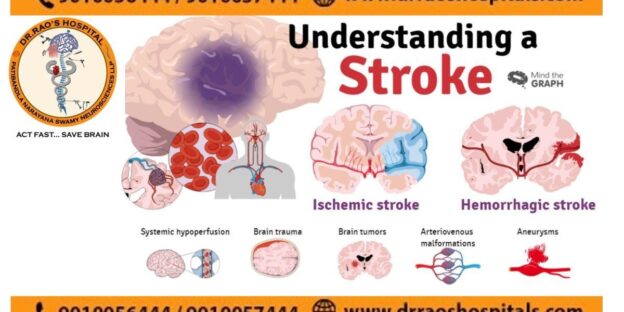Introduction
Stroke is a devastating condition that requires prompt medical attention and specialized care. In recent years, neurosurgery has emerged as a critical component in managing and recovering stroke patients. In this blog, we explore the significant role of neurosurgery in stroke care, specifically focusing on Dr. Rao’s Hospital, recognized as the best comprehensive stroke center. The hospital excels at offering cutting-edge neurosurgical interventions that optimize outcomes and improve patients’ quality of life under the direction of Dr. Rao, a renowned endovascular and cerebrovascular neurosurgeon with dural training.
Understanding Stroke: Causes, Types, and Impact
To comprehend the role of neurosurgery in stroke management, it is essential first to understand the causes, types, and impact of strokes. Ischemic strokes, caused by blocked blood vessels, and hemorrhagic strokes, resulting from ruptured blood vessels, require different treatment approaches. Dr. Rao’s expertise in cerebrovascular neurosurgery enables precise diagnosis and tailored interventions to address the specific type and location of the stroke.
Comprehensive Stroke Center: A Hub for Specialized Care
Dr. Rao’s Hospital is a comprehensive stroke center offering a multidisciplinary approach to stroke care. The hospital’s state-of-the-art facilities, advanced imaging technologies, and dedicated stroke teams ensure swift and accurate diagnosis, allowing for timely intervention. Dr. Rao‘s leadership and expertise in dural-trained cerebrovascular neurosurgery further enhance the hospital’s capabilities in providing specialized care for stroke patients.
Benefits of a Dural-Trained Cerebrovascular Neurosurgeon
The presence of a dural-trained cerebrovascular neurosurgeon, such as Dr. Rao, within the stroke center brings invaluable benefits to patients. Dural-trained neurosurgeons have extensive experience in managing complex cerebrovascular conditions, including stroke. Because they have had special training, they can do delicate procedures like endovascular interventions, aneurysm repair, and arteriovenous malformation (AVM) treatment with great accuracy and little risk.
Endovascular Interventions: Advancing Stroke Treatment
Endovascular interventions have changed how strokes are treated by letting neurosurgeons treat damaged blood vessels inside the brain using barely invasive techniques. Dr. Rao’s proficiency in endovascular procedures enables him to remove blood clots, restore blood flow, and minimize brain damage in stroke patients. This advanced approach offers benefits such as reduced procedural risks, shorter recovery times, and improved long-term outcomes.
Rehabilitation and Recovery Strategies
While acute stroke care is vital, post-stroke rehabilitation is equally critical for patients’ recovery. Dr. Rao’s Hospital adopts a comprehensive approach encompassing neurosurgical interventions, rehabilitation services, and ongoing support. Rehabilitation programs, including physical therapy, speech therapy, and occupational therapy, aim to restore functionality, promote independence, and improve stroke survivors’ overall quality of life.
Empowering Patients and Caregivers
Dr. Rao’s Hospital empowers patients and their caregivers throughout the stroke care journey. Educational resources, support groups, and counseling services are provided to ensure that individuals and their families understand the condition, treatment options, and strategies for long-term management. Dr. Rao’s Hospital fosters a patient-centric environment that prioritizes individualized care and improved outcomes by fostering open communication and collaboration.
Conclusion
Neurosurgery is pivotal in stroke management and recovery, offering advanced interventions that optimize outcomes and enhance patients’ quality of life.
Dr. Rao’s Hospital Leading the Way
Dr. Rao’s Hospital, recognized as the best comprehensive stroke center, stands at the forefront of stroke care. Dr. Rao is a renowned dural-trained endovascular and cerebrovascular neurosurgeon. With his expertise and specialized training, Dr. Rao brings many benefits to stroke patients, ensuring the highest standard of care and optimal treatment outcomes.
Dr. Rao’s Hospital uses the newest neurosurgical techniques and a multidisciplinary approach to provide a wide range of stroke management services. This includes endovascular procedures, where Dr. Rao’s skills shine, allowing him to navigate the intricate blood vessels of the brain with exceptional precision. He can effectively restore blood flow, minimize brain damage, and improve patient outcomes through thrombectomy, stent placement, and coiling.
One big benefit of having a dural-trained cerebrovascular neurosurgeon like Dr. Rao is that they can treat complicated cerebrovascular conditions like aneurysms and arteriovenous malformations (AVMs) that can happen after a stroke. Dr. Rao has special training and knowledge that allows him to offer targeted interventions, such as surgical clipping or endovascular coiling, to treat these conditions effectively and stop them from worsening.
The role of rehabilitation and recovery cannot be understated in the journey of stroke patients. Dr. Rao’s Hospital recognizes the importance of comprehensive rehabilitation strategies tailored to individual needs. Collaborating with a team of skilled therapists and rehabilitation specialists, the hospital provides physical, speech, and occupational therapy to aid recovery. This integrated approach ensures stroke survivors regain functionality, improve mobility, and regain independence, ultimately enhancing their overall quality of life.
Dr. Rao’s Hospital prioritizes patient and caregiver empowerment throughout the stroke care journey. By providing educational resources, support groups, and counseling services, the hospital ensures that individuals and their families can access the knowledge and support necessary to navigate stroke-related challenges. Dr. Rao’s team fosters a compassionate and patient-centric environment where open communication and shared decision-making empower patients to participate actively in their recovery.
In conclusion, under Dr. Rao’s direction at the best comprehensive stroke center, neurosurgery is essential for stroke management and recovery. With the help of a cerebrovascular neurosurgeon trained in dural techniques and Dr. Rao’s Hospital’s all-around approach, stroke patients get the best care possible, including advanced interventions, rehabilitation plans, and ongoing support. With Dr. Rao at the helm, the hospital remains dedicated to improving the lives of stroke patients and their families, driving positive outcomes in stroke management, and enhancing overall well-being.







